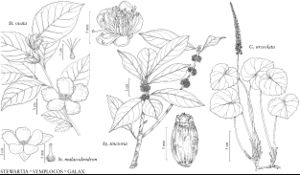Difference between revisions of "Symplocos"
Enum. Syst. Pl., 5, 24. 1760 ,.
FNA>Volume Importer |
FNA>Volume Importer |
(No difference)
| |
Revision as of 20:30, 24 September 2019
Shrubs or trees, glabrous or hairy (hairs simple, 1-celled, with transverse septa); new vegetative growth from axillary and/or pseudoterminal buds. Branches smooth at maturity, glabrous or white- or rufous-pubescent. Leaves often sweet tasting; blade with marginal teeth usually glandular, apex acute to acuminate, midvein abaxially prominent, adaxially raised, prominent, or impressed [rarely flat]. Flowers fragrant; sepals imbricate; petals imbricate, white or yellow [pink, reddish, or lavender]; filaments glabrous [hairy]; anthers rotund-ovate to spheric. Drupes usually blue, sometimes orange to brown [white], crowned by persistent calyx; endocarp 1[–5]-celled. x = 11.
Distribution
e, s United States, West Indies (Antilles), South America (Argentina, Brazil), Asia (China, India, Japan), Pacific Islands (Fiji), Australia, temperate, tropical, and subtropical areas.
Discussion
Species 318 (2 in the flora).
1 Leaf midveins impressed adaxially, blade margins closely serrate, serrulate, or dentate; inflorescences paniculate, usually internodal; flowers appearing with leaves; corolla lobes
2.5–5 mm; styles 2–4 mm; drupes bright blue to bluish black 1. Symplocos paniculata
Selected References
None.
Lower Taxa
Key
| 1 | Leaf midveins impressed adaxially, blade margins closely serrate, serrulate, or dentate; inflorescences paniculate, usually internodal; flowers appearing with leaves; corolla lobes 2.5-5 mm; styles 2-4 mm; drupes bright blue to bluish black. | Symplocos paniculata |
| 1 | Leaf midveins raised to prominent adaxially, blade margins usually obscurely crenulate-serrulate, teeth remote, sometimes nearly entire; inflorescences fasciculate, axillary; flowers appearing before leaves; corolla lobes 6-8 mm; styles 5-6 mm; drupes dark orange to brown. | Symplocos tinctoria |
